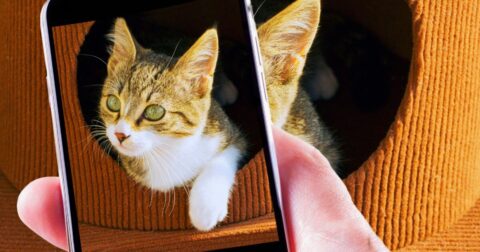Feature
Regenerative Agriculture Falls Short As a Climate Fix, New Study Finds
Research•5 min read
Reported
At least 10 percent of households no longer have their pandemic pets. In the future, digital pets could be an alternative.


Words by Steven Allison
Amid the recent maelstrom of global chaos, soul-stirring animal rescue videos offer brief snatches of respite. But good samaritans like Elli Smith at Sky Sanctuary Rescue face a worrying paradox: the huge uptick in social media followers they’ve experienced since the start of the pandemic comes with a troubling downside.
Covid restrictions have prompted a sharp upswing in worldwide pet ownership. According to an ASPCA survey, 19 percent of US households (around 23 million) acquired a cat or dog between March 2020 and May 2021.
Across the pond, PETA UK Vice President Elisa Allen explains the problem: “During lockdown, we saw a rise in people buying puppies to amuse themselves, with a subsequent surge in animals being surrendered to shelters. The casual acquirer often fails to consider the vast amount of time, attention, patience and money that properly caring for a companion animal requires, and they can’t cope.”
The 2021 ASPCA survey shows that 10 to 15 percent of households no longer have their pandemic pets. Some reports dismiss this figure as nothing at all, making trenchant criticisms of so-called alarmist headlines. However, 10 to 15 percent of households account for upwards of 2.5 million animals, and that’s not nothing.
In the future, technology could help solve this problem. Husband-and-wife duo Susan and Lee Cummings are building something called the Petaverse Network, an open standard for digital pets. Users will have virtual four-legged friends by their side at all times across the metaverse — chilling out at the edge of a browser screen by day, available for interaction through augmented reality (AR) headsets by night.
Speaking over Zoom from their home in Wales, Lee says, “Certain people, for whatever reason, aren’t suited to owning pets, and when they do, it can end badly. Digital pets offer the same visual and emotional benefits as physical animals, like decreased loneliness and increased mental wellbeing. AR tricks the brain, so they offer a close-enough alternative but without downsides like high running costs.”
Susan, who envisions some kind of magical His Dark Materials world of dæmons—dragons, owls, and even unicorns — discloses that she and Lee are thinking long-term. “Permanent ownership. Pets with the resilience, unlike real animals, to live on no matter what. We don’t want another Nintendogs — 24 million people bought it, but no one plays anymore. Imagine if digital pets could stand the test of time.”
Nintendogs, a real-time pet simulation by Nintendo, is an interesting reference. On release in 2005, the game was met with critical acclaim, partly because it helped people prepare for owning live animals — a bit like those creepy robot babies schools give pupils to care for. Lee feels certain that Petaverse Networks’ furry creations can achieve the same, only with greater authenticity. “What if these are like training wheels? What if, before you get a pet, you have to prove you can look after and understand the needs of a virtual animal first?”
PETA’s Elisa Allen appears to be on the same page. “Having a virtual companion animal is an option for those who are interested in animals but not ready for the very real, lifelong responsibility of bringing a living one into their home. For those individuals, a virtual animal or a plush toy is absolutely the better choice.”
Digital Pets, in Elisa’s opinion, are simply the latest innovation to prove we’re coming to understand that animals deserve greater respect. Another example is CGI tech. “It’s often used in place of live animals during filming, sparing animals the stress of transport to, and the noise and bright lights of, a film set. This shows that in today’s developed society, exploiting animals for human entertainment is not only unacceptable but also completely avoidable.”
Then there’s agriculture, where farmers are deploying a broad range of emerging technologies for the sake of animal welfare. These include remote monitoring devices for keeping an eye on livestock health; automated dairy installations for milking cows at their convenience; and feeding systems for ensuring animals have access to a mix and quantity of food that suits their needs. Smart farming, though, is a divisive space.
As we contemplate this seemingly innocuous shift to digital pets, a big question pops up: what becomes of our companion animals? In other words, might we one day completely replace the loyal denizens of our carpets (and sometimes couches, when permitted) with algorithms?
The Cummings’ don’t picture this happening. Instead, they foresee a place on this planet for both real and virtual creatures — maybe even with some “furry prisoners” returned to the wild. The pair do, however, hope for an end to the “horrific breeding” that looks set to afflict cats and dogs ad infinitum unless those who pay for it see the error of their ways.
This unethical practice has Elisa’s hackles rising too. “If people stopped buying animals from breeders and pet shops, we’d no longer see mother dogs kept in squalid conditions at puppy farms, where they are forced to churn out litter after litter, and breeders would stop selectively breeding dogs with genetic defects that cause breathing difficulties and put them at risk of diseases.”
The concept of lifelike virtual pets sounds more utopian than dystopian—probably why Susan, flanked by two Black Mirror wall prints, describes her firm’s vision as, “Very White Mirror — like the TV series, but in a good way.” Lots of people, especially tech heads, will support the idea with fire-in-the-belly verve. But we still have millions of animals in need of homes, so perhaps a jaunt to the local rescue center is a timelier solution.